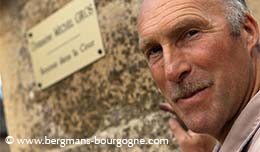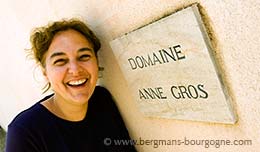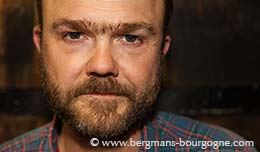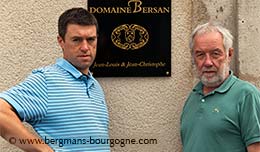
ne week was all it took. Then he was hooked. Back in high school Marc Soyard, today at Domaine de la Cras, undertook one week of work placement at the now defunct Domaine Carré-Courbin in Beaune. From then on he knew what he wanted to spend his life doing.
Originally from the Jura, Marc Soyard has brought new life to a part of Burgundy which has been neglected for a long time. The area around Dijon once boasted an abundance of vineyards. In 1892 there were 1200 hectares of vineyards. Today only a fraction of that remains, mainly because of urbanisation and vineyards not being replanted after the phylloxera crisis.
 – Back in the day Dijon had more vineyards than Gevrey-Chambertin, explains Marc Soyard. At the time of the Dukes of Burgundy it was well-known. Climats like Le Chapître and Montre-Cul have been planted for a very long time. There are lieux-dits that have disappeared as Dijon has grown. Many lovely terroirs are gone.
– Back in the day Dijon had more vineyards than Gevrey-Chambertin, explains Marc Soyard. At the time of the Dukes of Burgundy it was well-known. Climats like Le Chapître and Montre-Cul have been planted for a very long time. There are lieux-dits that have disappeared as Dijon has grown. Many lovely terroirs are gone.
He went to wine school in Beaune and finished there in 2003. A few internships followed, mainly in the Rhône valley, and then more studies. His goal was to return to Burgundy. He applied for a job in Vosne-Romanée, at Domaine Bizot, and got it.
– I worked at Domaine Bizot from 2007 to 2013, Marc Soyard continues. In 2014 I started my own thing with Domaine de la Cras. I had acquired some vineyards in 2012, but it was not enough to make a living.
 Marc Soyard does not come from a winegrower family. His great-grandfather was a négociant in the south of France, but that was his only connection to the wine world prior to his own adventures.
Marc Soyard does not come from a winegrower family. His great-grandfather was a négociant in the south of France, but that was his only connection to the wine world prior to his own adventures.
Domaine de la Cras existed already before the arrival of Marc Soyard. It was created in 1983 by Jean Dubois, a farmer with a soft spot for vines and who planted five hectares of pinot noir and three hectares of chardonnay.
– It had always been vineyards here, but just for personal consumption, says Marc Soyard. Jean Dubois bought vineyards and planted. Started with pinot noir and continued with chardonnay. Initially it was just two hectares. At the time of his death in 1999 he had six hectares. His nephew continued and carried on until he passed away in 2011. His wife then briefly took on the domaine with the help of hired hands.
 The domaine was later bought by the City of Dijon and became part of an 160 ha area on the plateau above Dijon, an area created with young farmers in mind.
The domaine was later bought by the City of Dijon and became part of an 160 ha area on the plateau above Dijon, an area created with young farmers in mind.
– The domaine wasn’t particularly developed. They would sell wine locally, to people passing the domaine. Some years they would bottle, some years they would sell the wine to négociants. When I arrived there were 15 000 bottles in stock, something which helped me to get started financially.
What also helped was people’s curiosity. When wine from around Dijon became a thing again after more than a century it did of course spark an interest. And as Marc Soyard points out, Jean-Yves Bizot was of great help as well.
When he was asked by the City of Dijon to take on Domaine de la Cras he was happy to do so, but at the same time not quite sure what he wanted to do with the domaine.
 – I had tasted some of the wines by the previous owner, he says, but I wasn’t too happy with them. I was really in unknown territory. I was walking around the vineyards. Stony, very well-drained. Red soil. There was a potential to improve things by doing more of the work manually.
– I had tasted some of the wines by the previous owner, he says, but I wasn’t too happy with them. I was really in unknown territory. I was walking around the vineyards. Stony, very well-drained. Red soil. There was a potential to improve things by doing more of the work manually.
With time things improved. He began to understand the vineyards better and how to vinify each parcel. I have more experience.
– The soil has improved thanks to the biodynamic farming I introduced. 2016-2017 I began to see the difference in the soil. The structure changed. Even the colour. The soil became darker, less compact and had more life.
The vineyards around the domaine, in Plombières-lès-Dijon, to the immediate west of Dijon, produce three red cuvées, three white and one rosé. All are regional appellation.
The red cuvées are the Bourgogne rouge, the monopole Cras and the l’Equilibriste.
 – They were planted in different years, says Marc Soyard. And more importantly they are different types of pinot noir. Cras is selection massale. Bourgogne rouge is a blend of selection massale and clones. l’Equilibriste is one single clone, the 113. The average age of the vines of the domaine is 35 years.
– They were planted in different years, says Marc Soyard. And more importantly they are different types of pinot noir. Cras is selection massale. Bourgogne rouge is a blend of selection massale and clones. l’Equilibriste is one single clone, the 113. The average age of the vines of the domaine is 35 years.
The white cuvées follow the same pattern – the Bourgogne blanc, the monopole Cras and the l’Equilibriste.
– The white l’Equilibriste is young vines, says Marc Soyard. It’s chardonnay and pinot blanc. Large wooden tanks are used both for vinification and élevage. It’s bottled after ten months. The Bourgogne blanc on the other hand is vinified in small barrels, 228 litres. It’s bottled after 13 months.
Technically he could plant more in the Coteaux de Dijon. But he has decided against it. It would be convenient to have the vineyards close to the domaine, but from a frost and hail point of you it would be risky to have all vineyards in the same place.
 Therefore he has vineyards in Villers-la-Faye, which is a Bourgogne Hautes-Côtes de Nuits, in Ladoix-Serrigny, the cuvée Hermaïon, and in the suburbs of Dijon, the Bourgogne Montre-Cul.
Therefore he has vineyards in Villers-la-Faye, which is a Bourgogne Hautes-Côtes de Nuits, in Ladoix-Serrigny, the cuvée Hermaïon, and in the suburbs of Dijon, the Bourgogne Montre-Cul.
– Hermaïon comes from a plot below the monopole of Domaine d’Arduy, the Clos des Langres. It is clay only soil. I don’t know the story of this vineyard, but I think the vines are about 70 years old.
Montre-Cul is a lieu-dit which really touches the city of Dijon. Its six hectares is right in the middle of the buildings, on a slope which varies from 257 metres to 307 metres in altitude.
– I have 33 ares, says Marc Soyard. We are about ten owners. Pataille, Derey, Regis Bouvier, but now it is his brother Rene Bouvier, Chateau de Marsannay, Chapuis, Confuron-Cotetidot and a few more. It’s a wine which is always very austere. The soil there is much lighter there. You have clay, but it is lighter. Well-drained soil. Easy to work. Not heavy at all.
 Anyone drinking av bottle of Marc Soyard’s pre-2022 Montre-Cul will notice it says Montre-Luc on the label. This has to do with him not handing in the correct paper work when he took on this vineyard. As a result he was not initially allowed to put Montre-Cul on the label.
Anyone drinking av bottle of Marc Soyard’s pre-2022 Montre-Cul will notice it says Montre-Luc on the label. This has to do with him not handing in the correct paper work when he took on this vineyard. As a result he was not initially allowed to put Montre-Cul on the label.
There are always experiments going on at the domaine. Marc Soyard says it is an advantage to have just one appellation, just the regional appellation. It lets him try new things.
– It gives me the freedom to have some fun. If you have a hectare of Bâtard-Montrachet you can’t do that, he smiles.
There is the Acte I and II, solera type wines where several vintages are blended and only 600 bottles produced.
– It’s a wine which is a bit on the oxidised side. Long élevage. It’s more complex since each vintage brings something to the blend.
There is the orange wine Australe made from pinot blanc. There are some sparkling cuvées, some Pét-Nat bottlings. Vin de voile from pinot noir and chardonnay. And more.
– I have taken on 30 hectares from my father-in-law. It’s in Étevaux, in the plain east of Dijon. He was a cereal farmer, but retierd. I have planted two hectares of vin de France. Various grape varieties such as savagnin, pinot noir, aligoté and chardonnay. It’s for fun. I just want to make a simple, entry-level wine. I have also started to grow barley, to make whisky.
© 2025 Ola Bergman














